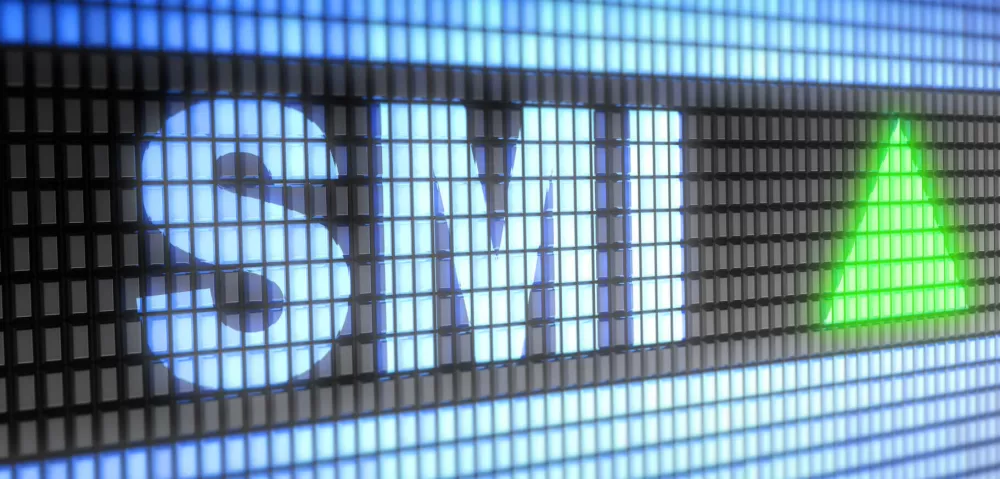The SMI is generally the first index mentioned by local and foreign media in relation to the Swiss stock market. Here, moneyland.ch answers the most important questions about investing in the SMI.
What is the SMI?
The Swiss Market Index was launched on June 30, 1988 by what is now the SIX Swiss stock exchange. The SMI replicates the price developments of the 20 currently-largest and most liquid Swiss stocks quoted on the SIX exchange. It is often used as an indicator of the Swiss stock market as a whole.
How is the SMI calculated?
The SMI rate is based on the average prices of the 20 underlying stocks. But the weighting given to each stock in the calculation varies between stocks. The bigger the market capitalization of a company’s publicly-traded stocks is, the bigger its influence on the SMI rate is. However, an individual stock can never make up more than 18 percent of the SMI rate.
The SMI only accounts for stock prices. Stock dividends are not accounted for when calculating the index. But there is a version of the SMI known as the SMIC that does include dividends, based on the premise that dividends are reinvested back into the underlying stocks.
Does the SMI accurately reflect the Swiss stock market?
The companies tracked by the SMI collectively account for around 75 percent of the Swiss stock market (based on free float market capitalization). That may seem like a big part of the stock market, but you should bear in mind that the SMI only tracks the 20 biggest Swiss companies, so it offers relatively little diversification. Additionally, most of the stocks underlying the index are large, multinational corporations that do a large part of their business outside of Switzerland.
How can I invest in the SMI?
There are many ways to invest in the SMI directly or indirectly. They include the following:
- Buy shares in an exchange-traded fund (ETF) that replicates the SMI.
- Buy shares in an index fund that replicates the SMI.
- Buy shares in the companies tracked by the SMI directly.
- Buy a tracker certificate that tracks the SMI.
- Open a fund savings plan which uses mutual funds, ETFs, or index funds that track the SMI.
- Use a digital asset management service (robo advisor) that invests in the SMI.
- Buy shares in an actively-managed mutual fund that invests in SMI stocks.
- Use an actively-managed asset management service that invests in SMI stocks.
It is important to note that employed residents of Switzerland generally invest in the SMI already through their occupational pension funds.
Important: Actively-managed mutual funds and asset management services are usually much more expensive than passively-managed ETFs and index funds, so in many cases they are not optimal investment solutions. For that reason, this guide focuses on answering questions about SMI ETFs, SMI index funds, and investing in SMI stocks directly or using tracker certificates. Refer to the guide to digital asset management services and the guide to fund savings plans for more information.
Which ETFs can I use to invest in the SMI?
The following ETFs available to private investors in Switzerland accurately replicate the SMI.
| Fund |
ISIN |
Cost (TER) |
| UBS ETF (CH) – SMI (CHF) A-dis |
CH0017142719 |
0.2% per year |
| iShares SMI ETF (CH) |
CH0008899764 |
0.35% per year |
Important: There are other ETFs that replicate other Swiss indexes like the Swiss Performance Index (SPI) which are cheaper than SMI ETFs, or have other advantages. For example, the more broadly diversified iShares Core SPI ETF (CH) fund invests in the 200 Swiss companies tracked by the SPI, including the 20 companies tracked by the SMI.
For tax reasons, you should always use ETFs that are domiciled in Switzerland to invest in Swiss stocks. Both of the SMI ETFs in the table above are domiciled in Switzerland.
How much does using ETFs to invest in the SMI cost?
The UBS ETF in the table above has a total expense ratio (TER) of 0.2 percent per year. The iShares ETF is slightly more expensive, with an annual TER of 0.35 percent.
Important: Depending on which bank or stock broker you use, you may have additional costs related to investing in ETFs. These may include fees for buying and selling shares in the ETF (brokerage fees, for example), taxes and stock exchange fees, and regularly recurring costs like custody fees. Depending on which service providers you use, these additional costs can be much higher than the TER charged by the fund itself. Finding the most affordable broker using the moneyland.ch online trading comparison is recommended.
Do SMI ETFs pay out dividends?
Yes. Both of the SMI ETFs listed in the table above distribute dividends. Dividends are not automatically reinvested into the fund. That is a disadvantage for long-term investors – at least if you assume that the SMI will continue to gain value. If you want to invest in the SMI over a long term, it is worth looking at ETFs that automatically reinvested dividends (accreting ETFs).
Where are the ETFs that track the SMI based?
Both of the ETFs listed in the table above are domiciled in Switzerland. You can find a fund’s domicile in its factsheet, or in the official documentation provided by the fund’s manager. In most cases you can also determine which country a fund is domiciled in using the two-character country code at the start of the fund’s international securities identification number (ISIN). Examples of country codes are CH (Switzerland), LU (Luxembourg), and IE (Ireland).
For investing in Swiss stocks and/or the SMI, using a fund that is domiciled in Switzerland is advantageous. The reason is that if you invest in an ETF domiciled in Switzerland, you can reclaim the withholding tax on dividends from Swiss stocks in full. When you receive Swiss dividends, a 35 percent withholding tax is deducted before they are paid out. After you correctly declare your full dividends in your tax returns (dividends before deducting withholding tax), the Swiss withholding tax is reimbursed in full. That applies to both distributing and accreting ETFs.
There are also foreign ETFs that use indexes which are similar to the SMI. The Xtrackers Switzerland UCITS ETF 1D fund is one example. But because these are domiciled abroad (Luxembourg, in the case of the Xtrackers ETF), you cannot reclaim the withholding tax in full. This results in poorer performance over long terms.
This rule only applies to ETFs that invest in Swiss stocks. For investing in foreign stocks, using ETFs that are domiciled in Ireland or Luxembourg is more optimal for investor in Switzerland, with regard to withholding taxes.
What is the difference between a physical and a synthetic ETF?
Both of the SMI ETFs in the table above physically replicate the SMI. That means these funds actually buy shares in the 20 companies tracked by the SMI.
Synthetic ETFs, on the other hand, only invest part of your money into actual SMI stocks, with swaps being used to replicate the index.
Physical ETFs are considered more secure than synthetic ETFs because the fund’s assets are largely protected in the event that the fund’s manager declares bankruptcy.
Which index funds can I use to invest in the SMI?
As with ETFs, there are only two index funds available to private investors in Switzerland that accurately replicate the SMI.
| Fund |
ISIN |
Cost (TER) |
| CSIF (CH) Equity Switzerland Large Cap Blue FB |
CH0214404714 |
0.1615% per year |
| iShares SMI Equity Index Fund (CH) Class D CHF |
CH0342181796 |
0.13% per year |
Important: As with ETFs, the selection of index funds based on more broad Swiss indexes like the SPI is larger and, in some cases, these solutions may be more suitable.
What is the difference between an SMI index fund and an SMI ETF?
Compared to the two SMI ETFs, the two index funds in the table above have lower ongoing costs, at 0.1615 percent per year in the case of the CSIF (CH) Equity Switzerland Large Cap Blue FB and 0.13 percent per year in the case of the iShares index fund.
Unlike the two SMI ETFs, both of these index funds are accreting funds. Dividends paid out by the individual companies are reinvested directly within the fund, so you do not receive any dividend distributions. This is advantageous for long-term investments, as long as the SMI gains value over time.
There are also several principal differences between index funds and ETFs. One important difference is that shares in index funds can only be bought or sold at the end of each trading day. Shares in ETFs, on the other hand, can be traded at any time during trading hours, just like shares in stocks. You can find more differences between index funds and ETFs here.
Can I invest in the SMI by buying individual stocks?
Yes, you can buy shares in the stocks that make up the SMI yourself using a stock broker. But accurately replicating the SMI by buying individual SMI stocks yourself is not worth it in most cases. Buying shares in an SMI index fund or ETF makes more sense for most investors.
Are tracker certificates a good solution for investing in the SMI?
Service providers like BNP Paribas, UBS, and ZKB offer tracking certificates that accurately replicate the SMI. But tracker certificates are problematic for long-term investments in the SMI.
ETFs and index funds invest directly in the underlying assets. In the case of the SMI, that means these funds buy shares in the 20 companies tracked by the index. But that is not the case with tracker certificates.
Tracker certificates replicate the index using derivatives, and do not fall under the law governing collective investments that is meant to protect investors. Your investment is not secured in the event of the certificate’s issuer declaring bankruptcy, which largely is not the case with ETFs and index funds (at least those which use physical replication).
Furthermore, tracker certificates are not regulated by Finma, and often are not transparent. That means it is very important that you understand the exact terms and conditions. For example, depending on the individual certificate, you may not benefit from dividend distributions or accretion.
You can find more differences between tracker certificates and ETFs here.
What are the advantages of investing in the SMI?
By using ETFs or index funds, you can invest in the 20 largest Swiss stocks, which collectively represent 75 percent of the Swiss stock market, at a relatively low cost. That means you can cheaply and easily participate in Swiss blue chips, three of which are also among the top ten biggest public companies in Europe.
Nine of the SMI’s 20 underlying stocks are dividend aristocrats. These are companies that have consistently raised their shareholder dividends for the past ten years or more, though of course, this can change in the future. In short: The SMI tracks Swiss companies which have stable business models and have managed to pay out dividends regardless of economic changes.
What are the disadvantages of investing in the SMI?
The 20 biggest Swiss companies may represent 75 percent of the Swiss stock market, but they are only a fraction of the more than 200 exchange-listed Swiss companies. If you invest only in the SMI, your investment will not be adequately diversified. The SMI does not include any small and medium-sized companies, which often have bigger growth potential than large companies.
What is more, 50 percent of the SMI’s rating is made up of the stock prices of just three companies: The two pharmaceutical giants Novartis and Roche, and food-processing giant Nestlé.
The SMI is also poorly diversified in terms of industry sectors. The healthcare sector dominates with 41 percent, followed by consumer goods (25 percent) and financial services (16 percent). That means just three industry sectors make up 82 percent of the SMI.
Another disadvantage is that the selection of SMI ETFs and index funds available to Swiss private investors is small compared to the SPI, for example.
Conclusion
If you want to invest in the biggest Swiss stocks over a long term, the SMI index funds and ETFs listed in the tables above all provide a good and affordable way to do that. Compared to the ETFs, the index funds have the advantages of being cheaper and automatically reinvesting dividends, which should result in better performance in the long term.
But if you value diversification and want to use just one investment vehicle to passively invest in the Swiss stock market, then an index which tracks a broader range of stocks is more suitable. One alternative is the SPI, which is much more diversified with stocks in more than 200 Swiss companies, compared to the SMI’s 20 companies.
But both the SMI and the SPI share the same risk because in both cases, just three companies (Nestlé, Novartis, and Roche) make up more than 50 percent of the index weighting.
More on this topic:
Compare Swiss stock brokers now
Compare Swiss asset management services now
Investing in the SPI






